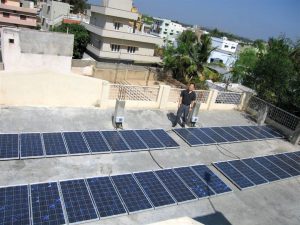China has faced floods, droughts and heat waves for millennia but as the average global temperature increases, we can expect the frequency, intensity and distribution of these extreme weather-related events to change.
Editor’s note
This article is an introduction to a series of on-the-ground reports examining adaptation efforts in mainland China and Hong Kong. It has been produced by Chinese journalists in partnership with other media outlets and international environmental organisations. Explore the rest of the series here.
Climate risk can be understood as the potential severity of impacts, taking account of underlying vulnerability and the probability of occurrence of a severe hazard, which may be slow-onset, such as sea level rise or drought, or an extreme weather event like a typhoon or heat wave.
China’s size and varied geographies make adapting to the wide variety of climate risks especially difficult. Climate change alters seasonal weather patterns and local climates differently but adaptation must also consider the significant differences in regions’ demographics, natural resources, topography, and levels of socio-economic development. The climate risks faced by highly urbanised areas, for example, may be quite different to those of underdeveloped rural ones.
The challenge for China’s central government, then, is to address the risks and opportunities of a changing climate whilst also meeting long term socio-economic goals.
The scale of the problem
China’s climate is changing. The annual mean temperature rise from 1951-2009 was about 1.4C. This has contributed to profound shifts in regional precipitation, with annual rainfall decreasing in the north and increasing in the middle and lower Yangtze River Basin in the south. It’s caused droughts and water shortages in the north and heavy flooding in the south, a phenomenon called the South Flood and North Drought.
China must get to grips with polluted water and soil, soil erosion, land degradation, and ecosystem and habitat loss. It must continue to feed one-seventh of the world’s population with just 9% of its total arable land and just 6% of global renewable water resources. Uneven development, urbanisation, rural-to-urban migration and industrial development have improved living standards for some while increasing socio-economic inequality for others.
Vulnerabilities to climate impacts are not static either. For example, in Guangzhou, southern Guangdong province, rapid rates of urbanisation along low lying coastal areas are increasing people’s exposure to weather hazards. Authorities must protect these growing populations and the infrastructure they depend on from increasingly intense and frequent tropical cyclones and storm surges.
Similarly, in Tibet, where the average altitude is more than 4,000 metres, mosquito species not previously recorded have established populations as a result of warming temperatures and the construction of the Qinghai-Tibet railway.
In 2009, residents of Lhasa city started reporting large numbers of mosquitoes when daytime temperatures reached a record 30.4C, much higher than the average daytime summer temperature of 22.5C. The mosquitoes are believed responsible for the spread of diseases such as West Nile virus and filarial worms in the region. With limited experience of living with large numbers of mosquitos, the local population was unprepared.
Some benefits
Not all impacts from climate change are harmful though. Rising temperatures have extended the growing period in northern China and reduced crop damage from cold weather. In some areas, land suitable for farming has expanded and the longer growing season has allowed famers to plant more than one crop a year. Farmers are planting southern rice varieties and winter wheat crops further north and west.The national cropping index (the ratio of the total area sown with crops to the total amount of cultivated land in a country each year) is up from 143% in 1985, to 164% in 2001, in part because of greater cultivation in the Tibetan Plateau and other highland areas.
In Tibet mosquito species not previously recorded have established populations as a result of warming temperatures
Adapting to uncertainty
Anticipating and responding to climate change impacts is complex and resource intensive. Climate adaptation is a headache for policymakers, businesses and individuals because there’s no single, known future climate to adapt to but instead a changing set of climate, environmental and socio-economic conditions. These changes mean that different groups of people, assets, infrastructure and economic sectors face varied and uneven risks.
Effective adaptation seldom consists of a single measure. It depends on linking policies and actions, and building capacity to implement them. To do this, China must develop comprehensive and integrated adaptation measures for sectors such as water resources, disaster risk reduction, human health, energy infrastructure, grasslands and animal husbandry, coastal zone management, agriculture, and tourism.
China released its National Adaptation Strategy (NAS) in 2013, the result of more than two years work by 12 ministries and government agencies, including the China Meteorological Agency and Ministry of Agriculture. It was coordinated by the National Development and Reform Commission (NDRC).
The NAS is arguably China’s most important climate adaptation policy to date. It shifts China’s adaptation response beyond assessment to the development of policies, providing a framework for Urban and Provincial Adaptation Plans through a set of guiding principles for provincial governments and line ministries. NDRC officials emphasise that the strategy is not a plan but rather an outline of work that will take time to implement.
Most recently, in February 2016, the NDRC and the Ministry of Housing and Urban-Rural Development drafted the Urban Climate Change Adaptation Action Plan. The details are yet to be released but the ambition is that by 2020 the plan will cover 30 pilot cities.
As climate conditions have begun to shift and social pressures evolve faster than infrastructure can keep up, sector level planners are turning to a combination of options to build resilience. China has started to make crucial steps toward a more holistic, forward-thinking water resource management policy that views water system resilience as part of the overall process of adapting to climate change.
Policymakers are also moving toward a stronger focus on conservation, preservation and changing allocation strategies. China is beginning to take more of an integrated river basin management approach, for example, through the development of a National Comprehensive Water Resources Plan.
Science based adaptation
Satellite data and other remote sensing tools are also being used more to provide a detailed and up-to-date picture of disaster risks. China recently developed a meteorological disaster atlas and has improved risk assessments for typhoons, rainstorms and droughts. There are also National Assessment Reports on Climate Change and impact assessment reports for the Yangtze River Basin, East China, Yunnan province, Poyang Lake and the Three Gorges Dam area.
However, at the provincial level, adaptation is not being uniformly addressed or integrated into five-year development plans. The NDRC acknowledges that many provincial and local officials lack capacity for adaptation planning. Some provinces, such as Inner Mongolia and Guangdong, are further along than others.
Adaptation is not being uniformly addressed or integrated into provincial development plans
In Inner Mongolia, the provincial Development Research Centre is embarking on an ambitious plan to be completed by the end of March 2017, that will cover water resources, agroforestry, ecology, urbanisation, energy, and grassland husbandry.
Guangdong province is working to restore Oi’ao Nature Reserve, a 650-hectare expanse of mangrove forests. Ecological degradation and pollution have compromised the ability of the Pearl River Delta’s coastal ecosystems, where many major cities are located, to buffer the forces of typhoons and high tides.
Mangroves are increasingly seen as essential to disaster risk reduction and climate adaptation efforts. Typhoon Hagupit pounded Guangdong in 2008 and revealed the resilience of healthy ecosystems compared to man-made infrastructure. While the typhoon caused enormous damage to Zhuhai city, destroying one-third of its granite seawall, the nearby Oi’ao Nature Reserve was unaffected.
In adapting to climate change, China’s leaders must contend with the country’s diverse geographies, vast population and competing development priorities, as well as the increasing economic disparity across regions.
Climate change poses an additional stress factor at a time when the country is already struggling to maintain healthy ecosystems and raise living standards. It’s within this challenging context that China’s policymakers, businesses and citizens must manage climate risk and build resilience.
Comprehensive risk based adaptation policies and plans are therefore essential to protecting vulnerable groups from hardship and arresting environmental degradation. Only then can China achieve sustainable development for all.







